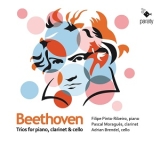 Ludwig van Beethoven: Trios für Klavier, Klarinette und Cello op. 11 & 38; DSCH – Shostakovich Ensemble (Filipe Pinto-Ribeiro, Klavier, Pascal Moraguès, Klarinette, Adrian Brendel, Cello); 1 CD Paraty 170332; Aufnahme 02/2020, Veröffentlichung 05/02/2021 (62'56) - Rezension von Remy Franck
Ludwig van Beethoven: Trios für Klavier, Klarinette und Cello op. 11 & 38; DSCH – Shostakovich Ensemble (Filipe Pinto-Ribeiro, Klavier, Pascal Moraguès, Klarinette, Adrian Brendel, Cello); 1 CD Paraty 170332; Aufnahme 02/2020, Veröffentlichung 05/02/2021 (62'56) - Rezension von Remy Franck
Es gibt zwei Klaviertrios von Beethoven, deren Violinpart auch von der Klarinette gespielt werden kann: Das Trio op. 11 (Gassenhauer-Trio) sowie das Klaviertrio op. 38 (Grand Trio), das in dieser Bearbeitung des Komponisten auf das 1799 entstandene Septett op. 20 zurückgeht.
Die drei Musiker des DSCH Ensembles bilden ein vorbildliches Trio. Der schöne Klarinetten-Ton von Pascal Moraguès, das warme, sonore Cello von Adrian Brendel verschmelzen mit dem immer präsenten Klavier von Filipe Pinto-Ribeiro zu einem sehr hohen Maß an Ausgewogenheit und Homogenität. Der große Atem beider Werke kommt daher sehr gut zum Ausdruck. Die Akzente sind sorgfältig gesetzt und abgestuft, die Tempi sind beherrscht, die Klanggewichte mit Umsicht ausbalanciert. Und immer wieder überrascht dabei die interpretatorische Einigkeit, die das A und das O dieser beiden Einspielungen ist. Ausstrahlung und Spannung bleiben vom ersten bis zum letzten Ton erhalten.
There are two piano trios by Beethoven whose violin part can also be played by the clarinet: The Trio op. 11 (Gassenhauer-Trio) and the Piano Trio op. 38 (Grand Trio), which in this arrangement by the composer goes back to the Septet op. 20, written in 1799.
The three musicians of the DSCH Ensemble form an exemplary trio. The beautiful clarinet tone of Pascal Moraguès, the warm, sonorous cello of Adrian Brendel blend with the ever-present piano of Filipe Pinto-Ribeiro to a very high degree of balance and homogeneity. The great breath of both works is therefore very well expressed. Radiance and tension are maintained from the first to the last note. The accents are carefully set and graduated, the tempi are right, the sound is carefully balanced in a singular interpretive harmony.






















